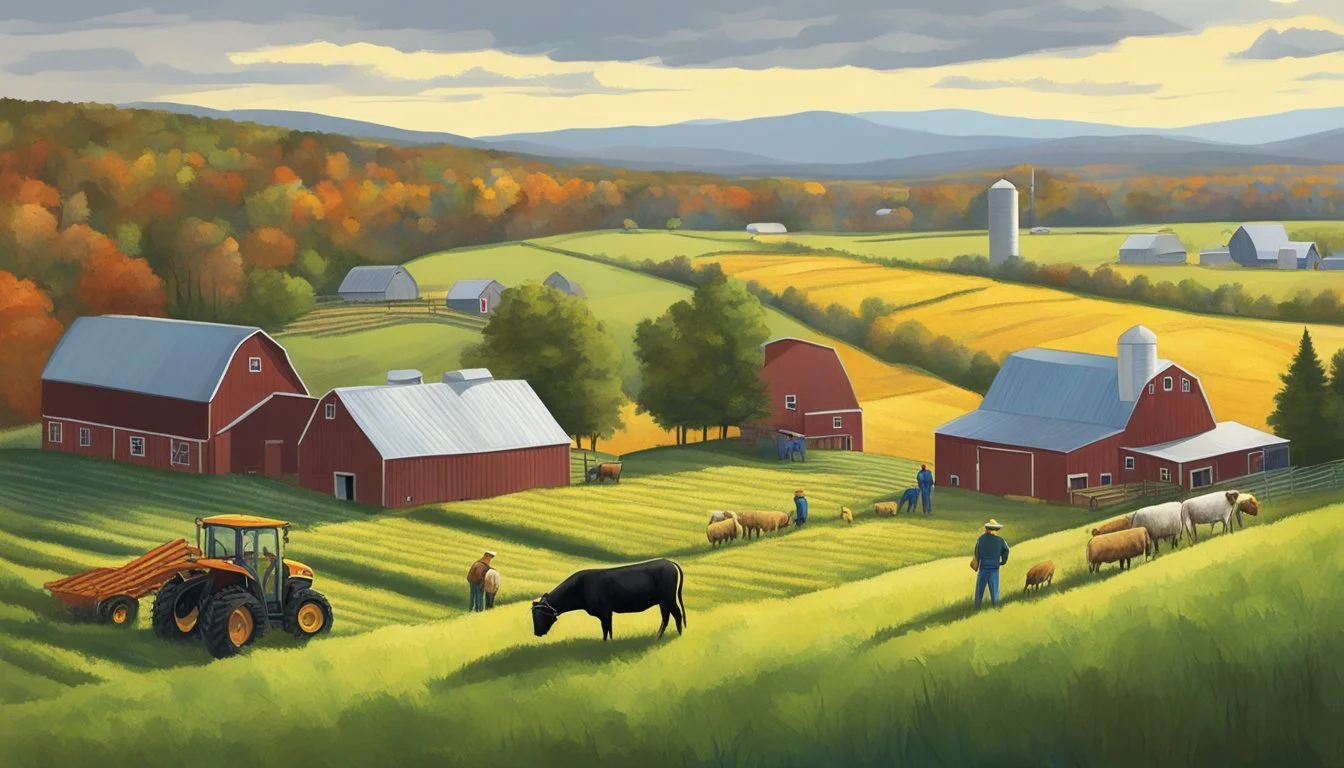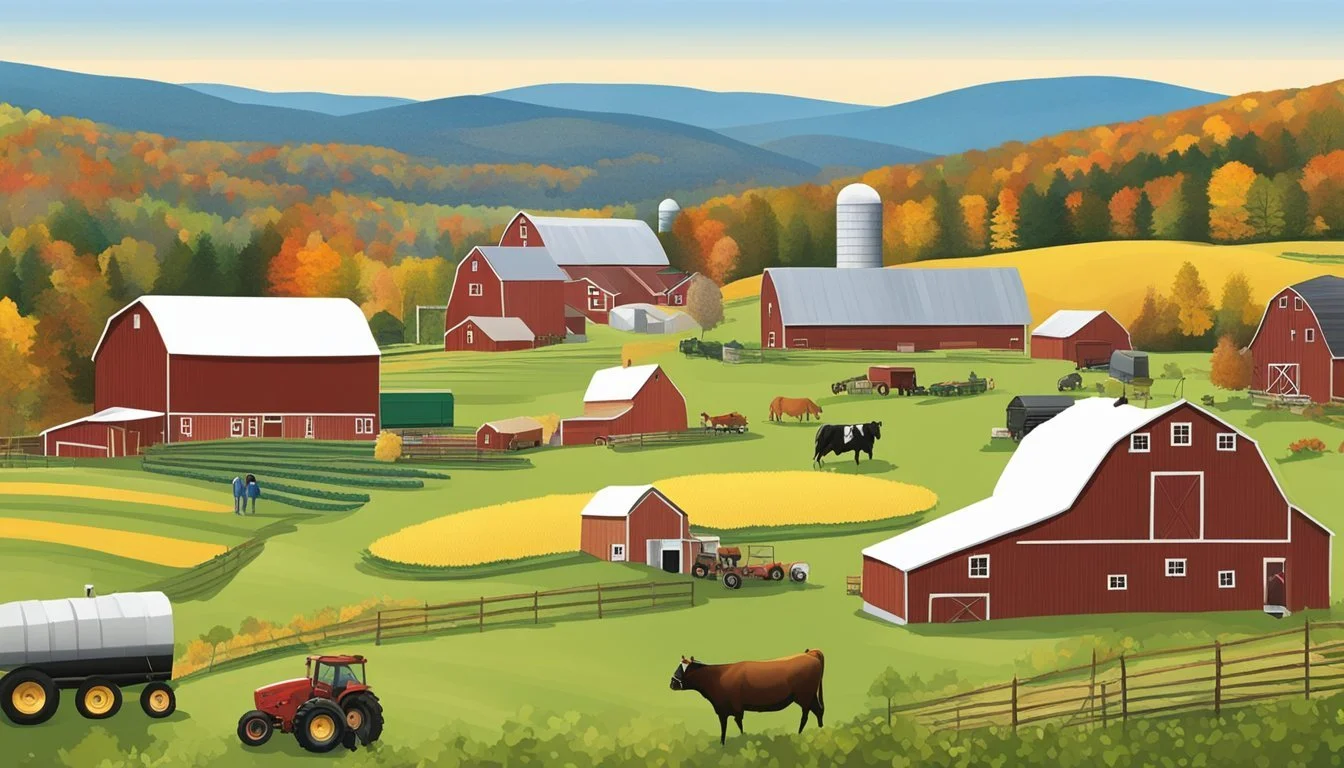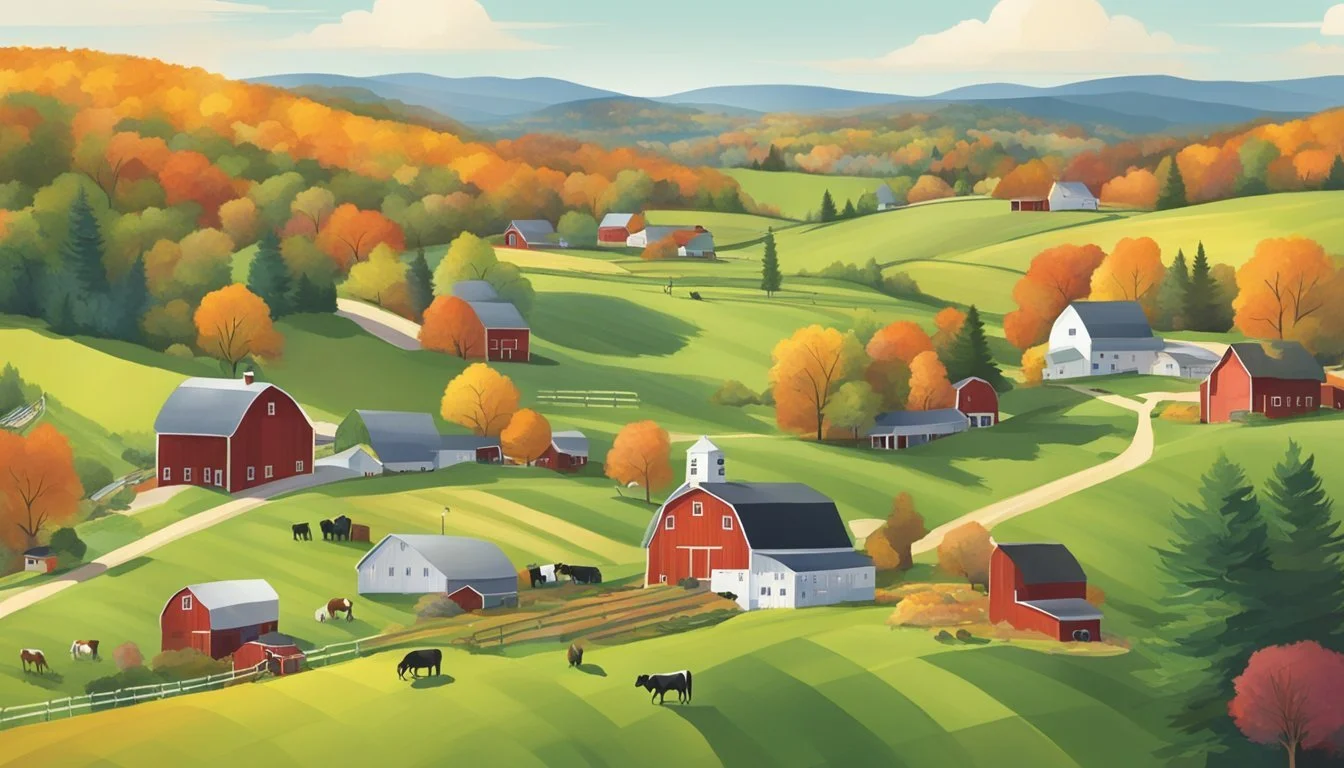Farming Communities in Vermont
Sustainable Practices and Local Impact
Farming communities in Vermont play a crucial role in the state's economy and cultural heritage. With its scenic landscapes and fertile soil, Vermont is home to numerous farms and ranches, including Cobble Hill Farm in Londonderry and the picturesque Shelburne Farms Inn overlooking Lake Champlain. Vermont agriculture supports a sustainable and local food system, ensuring fresh produce and products reach both residents and visitors.
The state boasts a variety of farmhouses, ranging from historic plantations to modern homesteads, reflecting Vermont's rich agricultural history. These properties offer a glimpse into the traditional farming lifestyle while also showcasing innovative sustainable farming practices. The average price for farmland in Vermont is competitive, with each acre valued at about $11,631, making it an attractive option for aspiring farmers.
Windham County leads with the most land and farms for sale, contributing significantly to Vermont's rural charm. These communities not only provide economic benefits but also foster social connections and heritage preservation. Vermont's farming communities are known for their dedication to farm-to-table culinary experiences, drawing agritourists who are eager to explore and taste the state's agricultural bounty.
History and Background of Vermont Farming
Vermont's farming history reflects a deep connection between its people and the land. Early farmers in the state relied on small subsistence farms, growing diverse crops and raising various animals.
By the 1820s, farming began to change in Vermont. Small, diverse farms started being replaced by larger, more specialized operations. The focus shifted toward commercial farming.
Sheep and Cattle Farming
Many farmers began raising sheep and cattle. Sheep farming became particularly popular, helping to support a thriving wool industry. Cattle farming supported dairy production, providing essential dairy products like butter and cheese.
Peak Agricultural Land Use
In the late 19th century, Vermont's agricultural economy reached its peak. By around 1870, close to 75% of the arable land was used for agricultural purposes. This period marked a high point for Vermont farmers and their productivity.
Transition to Sustainable Practices
Prominent figures like Frederick Billings played crucial roles in transforming Vermont farming. He introduced sustainable farming methods and focused on breeding Jersey cows for dairy production at Billings Farm in Woodstock. These practices aimed to teach farmers effective agricultural techniques.
Impact of the Civil War
The Civil War influenced farming dynamics as many fields transitioned to forested areas post-war. Farmers adapted to changing conditions, leading to a mix of open fields and new forest growth. This shift reflected broader trends in Vermont's agricultural and economic landscape.
Vermont's farming communities today build upon this rich history, embodying resilience and adaptability. The state's agricultural evolution highlights the significant contributions of its farmers and their enduring relationship with the land.
Current State of Vermont Agriculture
Vermont's agriculture is characterized by a diverse array of farming systems, with a significant emphasis on dairy farming and a growing commitment to organic and sustainable practices.
Dairy Farming and Livestock
Dairy farming dominates Vermont's agricultural landscape. The state's rolling hills host numerous dairy farms, producing high-quality milk, cheese, and other dairy products. Cows are the primary livestock, with the dairy sector being pivotal to the local economy.
Recent trends show a consolidation of dairy farms, with smaller operations merging to stay competitive. Farmers face challenges such as fluctuating milk prices and increased operational costs. Despite these hurdles, dairy remains the backbone of Vermont agriculture, contributing significantly to both employment and the state's cultural identity.
Organic and Sustainable Practices
A significant number of Vermont farms are adopting organic and sustainable farming methods. This shift is driven by consumer demand for organic produce and a growing awareness of environmental sustainability. Organic farms in Vermont avoid synthetic chemicals, relying instead on natural pest control and fertilization methods.
Sustainable practices include crop rotation, reduced tillage, and maintaining soil health through cover cropping. These methods help preserve the land for future generations while producing healthier food. The adoption of these practices is supported by various state programs and incentives aimed at promoting a greener agricultural sector.
Farming Systems and Crop Diversity
Vermont farms are not just about dairy and livestock. The state boasts a variety of farming systems and a diverse range of crops. Common crops include hay and corn, which are essential for livestock feed. Additionally, farms grow vegetables, fruits, and grains, catering to both local and regional markets.
The use of Community Supported Agriculture (CSA) and farmers markets is prevalent, with many farms selling directly to consumers. This direct market approach supports local economies and ensures that fresh, locally grown produce is readily available. Crop diversity in Vermont is essential for a resilient agricultural system that can withstand economic and environmental fluctuations.
Challenges Facing Vermont Farmers
Vermont farmers face significant challenges including access to land and escalating values, an aging population of farmers, and environmental impacts driven by climate change.
Land Access and Values
Access to farmland in Vermont has become increasingly difficult. Rising land values exacerbate this issue, making it hard for new and beginning farmers to secure property.
The average market value of Vermont farms increased by 13.5% from 2012 to 2017, reaching approximately $620,691.
These high costs require farmers to have substantial capital, making the pursuit of agriculture a financially intensive endeavor. Moreover, pressure to convert farmland for non-agricultural uses further limits availability, posing a threat to agricultural sustainability.
Aging Farmer Population
Vermont's farmer demographic is aging, with a growing number approaching retirement. This trend is part of a broader national pattern where the average age of farmers is increasing.
As older farmers retire, there is a pressing need for younger farmers to replace them. However, the transition is not straightforward – newer generations often face hurdles like acquiring necessary skills, access to capital, and navigating a challenging market.
Efforts to mentor and support young farmers are crucial but must expand to address this demographic shift effectively.
Climate Change and Environmental Issues
Climate change presents a significant challenge for Vermont farmers. Erratic weather patterns, such as increased rainfall and unpredictable temperature fluctuations, directly impact crop yields and the farming schedule.
Farmers must adapt to these changes by implementing resilient agricultural practices. This includes investing in infrastructure like drainage systems and utilizing more robust crop varieties.
Environmental stewardship also requires balancing farm productivity with sustainable practices to mitigate long-term impacts, making climate change a multifaceted issue for these communities.
Community and Economic Impact
Farming communities in Vermont contribute significantly to both the local economy and the cohesion of rural areas. They support local food systems and create job and educational opportunities.
Local Food and Economy
Local food production is a cornerstone of Vermont’s economic landscape. The state generates around $1.1 billion in agricultural cash receipts, primarily through dairy products, crops, and maple products.
Farmers markets and direct farm sales play a vital role in circulating money within the community.
Purchasing locally grown food helps to retain income within rural Vermont. Farmers gain higher margins by selling directly to consumers without intermediaries. This ensures that a larger share of the food dollar stays within the community, fostering economic stability and growth.
Job Creation and Educational Opportunities
Agriculture is a significant source of employment in Vermont, supporting thousands of jobs across various sectors. From farm labor to marketing and distribution, the farming industry provides diverse job opportunities.
Educational programs by entities like the University of Vermont and advocacy groups promote sustainable farming practices.
These initiatives not only equip Vermonters with essential skills but also inspire younger generations to pursue careers in agriculture.
Through workshops, internships, and formal education, the community builds a knowledgeable workforce prepared to innovate and sustain the agricultural sector.
Policies and Support Structures
Farming communities in Vermont benefit from a variety of programs, grants, and educational resources aimed at sustainable agriculture. They also have access to legal and business planning assistance crucial for maintaining viable farm enterprises.
Government Programs and Grants
Vermont's Agency of Agriculture plays a pivotal role in supporting farm businesses through various grants and government programs. The Farm Viability Program supports farmers with business planning and technical assistance.
Farmers can access the USDA New Farmers program to obtain financial support. Programs like 3SquaresVT assist in improving food security among farm households.
Educational Resources and Extension Services
The UVM New Farmer Project connects farmers with resources to strengthen their farming operations. Educational initiatives include workshops, online courses, and field days that deliver practical knowledge directly to farmers.
Extension services from institutions like UVM provide valuable consultations and research-based advice. These resources help farmers adopt innovative practices and improve productivity.
Legal and Business Planning Assistance
Legal aid is available through organizations like Vermont Legal Aid, offering support in healthcare enrollment and other legal intricacies.
Farmers also need robust business planning tools to ensure sustainability. The Legal Toolkit and the Vermont Housing and Conservation Board provide resources to navigate business challenges and secure farm viability. Access to these legal and business services supports the agricultural community in making informed decisions and securing their future.
Innovation and Development
Farming communities in Vermont are increasingly embracing modern techniques and collaborative approaches to ensure that they remain viable and sustainable. Key areas of focus include pioneering agricultural research, promoting sustainable food systems, and enhancing collaboration among stakeholders.
Research and Advancements
Vermont's agricultural sector is bolstered by ongoing research and innovative developments. Institutions and private entities invest in projects that improve crop yields, livestock health, and farming techniques.
Research areas:
Crop resilience: Enhancing resistance to pests and climate conditions
Dairy innovations: Boosting milk production and quality
Technology integration: Utilizing drones, sensors, and AI
Researchers aim to provide farmers with advanced tools and methodologies, helping them to overcome traditional agricultural challenges with sophisticated solutions.
Sustainable Food Systems
Focus on sustainable practices is essential for the longevity of Vermont's farming communities. Integrating environmentally friendly methods ensures productivity while preserving resources.
Sustainable initiatives:
Organic farming: Reducing chemical use
Water conservation: Implementing efficient irrigation systems
Soil health: Promoting crop rotation and composting
These practices help in reducing environmental impact and maintaining high-quality food production. Policies are informed by research findings to support sustainable farming efforts effectively.
Collaboration and Networking
Collaboration boosts innovation and resource-sharing among Vermont farmers, researchers, and policymakers. Networking events and cooperatives enhance community ties and facilitate knowledge exchange.
Key collaboration efforts:
Farm to Plate Network: Coordinating statewide food system initiatives
Agricultural grants: Fund allocation for innovative projects
Workshops and training: Providing education in modern agricultural practices
These collaborative efforts ensure a cohesive approach to addressing agricultural challenges, fostering a dynamic and supportive farming environment. Networking opportunities create pathways for collective growth and sustainability.
Ownership and Production Models
Ownership and production models in Vermont farming communities encompass traditional land purchases, emerging cooperative models, revenue diversification, and on-farm slaughter practices. These strategies influence both farm sustainability and farmers' income potential.
Traditional and Emerging Farm Ownership
Farm ownership in Vermont traditionally centers on fee simple ownership, where a single family or individual buys and owns the land outright. This model faces challenges from high land costs and limited availability.
Newer models, such as those promoted by the Farmland Access Program of the Vermont Land Trust, offer alternative pathways. These include cooperative ownership and community-supported arrangements, which aim to lower barriers to farmland access and enhance sustainability.
Diversified Farm Revenue Streams
Farmers in Vermont increasingly pursue varied revenue streams to enhance financial stability. Traditional sources like crop and livestock sales remain vital, but diversification is key.
Innovative income sources include agritourism, where farmers earn by hosting visitors for tours, events, or on-farm stays. Some farmers also engage in value-added production, creating products like cheeses, jams, or crafts, enhancing profitability through direct sales.
On-Farm Slaughter and Direct Sales
On-farm slaughter is an essential practice for many small-scale livestock farmers in Vermont. This allows for more control over meat quality and reduces transportation stress for animals.
Direct sales, such as farmers markets and CSA (Community-Supported Agriculture) programs, provide avenues for farmers to sell their products directly to consumers. This model helps keep more income within the community and fosters connections between farmers and customers.
Cultivation of Community and Culture
Vermont's farming communities are deeply rooted in traditions that foster both agricultural sustainability and rich cultural connections. These communities thrive on local support and engagement through various initiatives and events that highlight their unique agricultural and artisan products.
Community-Supported Agriculture (CSA)
Community-Supported Agriculture (CSA) plays a critical role in Vermont's farming landscape. CSA programs create a direct link between farmers and consumers, ensuring access to fresh, locally produced food. Members pay upfront for a share of the season’s harvest, which helps farmers with initial costs and provides a stable income.
Farmers offer a diverse range of products through CSA shares, including vegetables, fruits, dairy, cheese, and wool. This direct sales model not only benefits farmers economically but also strengthens the sense of community by fostering relationships between producers and consumers. The shared risk and reward create a resilient local food system and enhance food security.
Agricultural Festivals and Events
Agricultural festivals and events are pivotal in celebrating and promoting Vermont's rural heritage and community spirit. These gatherings serve as platforms where farmers, artisans, and food entrepreneurs can showcase their products and heritage. Popular events like the Vermont Dairy Festival and the Champlain Valley Fair draw large crowds, highlighting everything from cheese production to wool spinning.
Such events provide opportunities for networking and knowledge exchange, enhancing community bonds. They also educate the public about agricultural practices and the importance of supporting local farms. Through workshops, demonstrations, and tastings, attendees gain a better appreciation for the work and dedication involved in maintaining sustainable farming practices in Vermont.
Local Artisans and Food Entrepreneurs
Local artisans and food entrepreneurs add vibrancy and diversity to Vermont's rural communities. These small business owners often collaborate with farmers to create unique, locally produced items that highlight Vermont's agricultural bounty. Examples include artisanal cheese, specialty wool products, and the array of goods created by local food entrepreneurs.
These collaborations support the local economy and allow for innovative products that reflect the region's cultural heritage. By purchasing from local artisans and businesses, community members help preserve traditional skills and enhance the economic resilience of their rural communities. This synergy ensures the continuation of Vermont’s unique local cultures while promoting economic growth and sustainability.
Marketplace and Consumer Relations
The relationship between farmers and consumers in Vermont is built around direct engagements at local markets and proactive community involvement. These elements ensure that both parties benefit through mutual support and education.
Farmers Markets and Direct Selling
Vermont's farmers markets serve as vital hubs where consumers can purchase goods directly from producers. These markets provide fresh, locally-sourced produce, while allowing consumers to engage directly with farmers. This face-to-face interaction fosters trust and accountability, enhancing the consumer's shopping experience and supporting the farmer's business.
Direct selling also includes Community Supported Agriculture (CSA) models, where consumers purchase shares of a farm's harvest in advance. This model provides farmers with upfront capital and shared risk, while consumers receive regular fresh produce deliveries. Vermont's farmers have adapted to consumer demands by offering more flexible CSA options, making it easier for people to participate.
Consumer Education and Engagement
Consumer education is crucial in strengthening marketplace relationships. Farmers in Vermont actively educate consumers about sustainable practices and the origins of their food. This education happens through farm tours, workshops, and informational materials distributed at markets.
Organizations like the Northeast Organic Farming Association of Vermont (NOFA-VT) provide resources and training for both farmers and consumers. Manuals and guides help farmers enhance community engagement and foster better consumer relations.
Moreover, initiatives like the Vermont Farmers Food Center focus on creating a localized food system. These efforts empower communities by increasing economic autonomy and civic participation. By educating consumers, they ensure that the community understands the value of supporting local agriculture.
Sustainability and the Future
Vermont's commitment to sustainable agriculture is central to the future of its farming communities. Initiatives in education, community advocacy, and balanced growth work together to ensure the soil's health and the livelihood of the next generation of farmers.
Next Generation Farmers and Education
Educating new farmers is crucial for the sustainability of Vermont's agriculture. Programs focus on teaching best practices for soil health and sustainable farming techniques.
Organizations like the Vermont Sustainable Jobs Fund and the Center for Sustainable Agriculture offer workshops, resources, and mentoring opportunities. These efforts aim to equip young farmers with the skills needed to make informed decisions and run successful, sustainable farms.
Advocacy and Community Involvement
Community involvement plays a significant role in advocating for sustainable agriculture. Local organizations and state agencies work together to push for policies that support farming communities.
Events, public forums, and partnerships between farmers and policymakers are platforms for voicing needs and concerns. This collective effort strengthens Vermont’s agricultural fabric, ensuring that sustainability remains a priority.
Balancing Growth with Sustainability
Growth must be managed carefully to maintain sustainability. Vermont's Agricultural and Food System Strategic Plan 2021-2030 outlines strategies to balance economic growth with environmental stewardship.
Upcoming developments and expansions in farming practices are approached with caution. Emphasis is placed on practices that protect natural resources while allowing for business development and community advancement. This balance ensures long-term productivity and environmental health.







